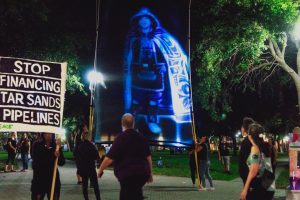In St. Petersburg Florida, “Creative demonstration” doesn’t even begin to explain how Campaign Coordinator Justin Morris chose to tell the story of stifled Indigenous voices in an ongoing battle for basic human rights. Justin was inspired to take action because “Indigenous people have been fighting since 1492 for the protection of their right to drink clean water, eat clean food and live on their own land”. In a courageous initiative to bring attention to the issues, 35 activists donated their time and energy over two days to spread the message in an innovative way.
Justin Morris is a longtime activist and the mastermind behind this demonstration. His passion for dismantling pipeline finance was instilled after his time at Standing Rock. Justin then went on to build the Florida Indigenous Rights and Environmental Equality coalition with 40+ groups to fight this issue locally. He tells of his experience hosting this demonstration.
Activists are gathered in Williams Park to amplify Indigenous voices in the fight against #TarSands. We are calling on JPMorgan Chase & Co. to STOP violating the Equator Principles by funding climate disaster.
Posted by Greenpeace USA on Friday, May 4, 2018
Megan Weeks: What is a Holo-Demonstration?
Justin Morris: A Holograph uses video technology to express a message in a very lifelike way. By using a large scale video projector and throwing an image onto 30-foot specialized screens we created the illusion of a Star Wars-like hologram. This was the first time this technology was used for environmental advocacy work in the United States.
MW: What inspired you to take action on behalf of Indigenous rights?
JM: One of the biggest fights my relatives all over Turtle Island (North America) are facing is Tar Sands oil expansion. Right now there are three massive pipelines being built from the Canadian Tar Sands across Turtle Island and to our oceans. If these pipelines are built they will pass over 2,100 bodies of water and violate the sovereignty of over 120 Indigenous Nations.
MW: Why was this a poignant way to express your message?
JM: This day in age, all the technology and distractions that we have in the world, the traditional tactics . . . kind of falls flat in people ears. Because of this, extraction of fossil fuels and the damage it does to Indigenous communities has been ignored for far too long. That is why we set out to amplify the voices of Indigenous peoples who are demanding that large corporate banks like JPMorgan Chase defund big oil projects. [Using this technology] was an effective and efficient way of reaching and expressing our message to the world.

Dozens of local community members enthusiastically interacted with activists from Greenpeace and were moved by the hologram’s message.
MW: How did people react to the Hologram and the message?
JM: The reaction was very warm and supportive. Dozens of local community members enthusiastically interacted with activists from Greenpeace and [coalition partner] Florida Indigenous Rights and Environmental Equality. Online, 9000 people interacted virtually and an estimated 100 people interacted on the local level.
MW: Can you talk about some of the challenges and highlights of this experience?
JM: One of the biggest things we overcame was managing the technical glitches that came up on the day of the action. The highlight of the demonstration was the inclusive and supportive community that was built over two days, involving 35 participant volunteers.
MW: Any advice for activists?
JM: Never stop thinking creatively about the tactics that you can use when getting across your message, don’t let a crazy off the wall idea stop you from making a big statement. At first, I didn’t think that this was possible, but with a lot of help and perseverance, we were able to make a huge statement!
To follow the movement in the Southeast, follow Greenpeace St. Pete on Facebook!



